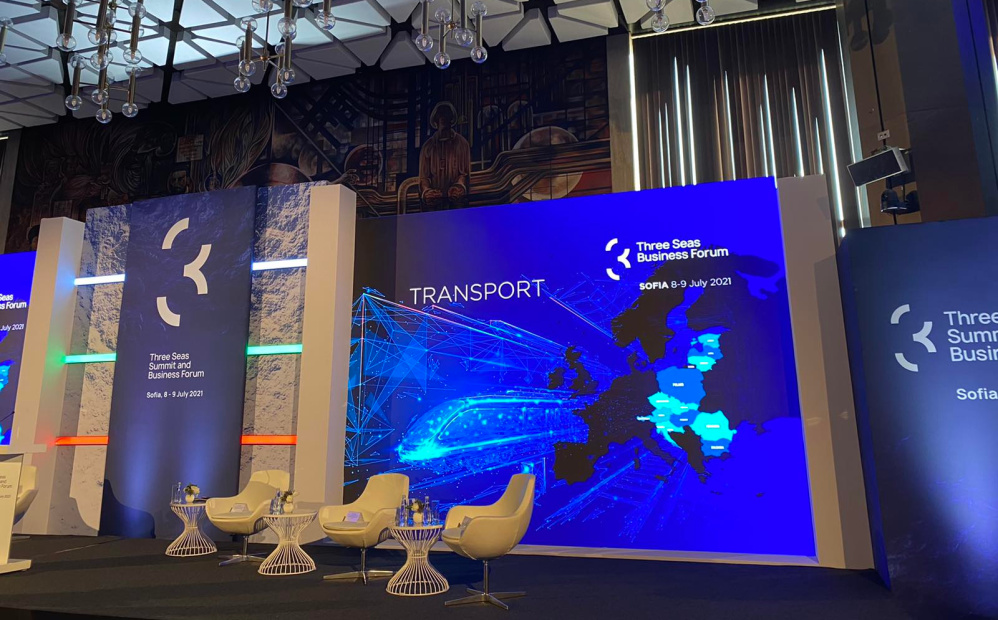Interview with Mr. Jordan Dimitrovski – Member of the Board of Directors of AmCham, General Manager of Aitonix, on the highlights from the digitalization panel at the “3 Seas Summit and Business Forum”, how it demonstrates the significance of successful digitalization, and the opportunities that an initiative of this magnitude creates for the neighboring countries.
1. You recently attended the “3 Seas Summit and Business Forum”. What did the event entail and according to your opinion, what can be singled out as most interesting for us?
The “3 Seas Summit and Business Forum” is one of the largest gatherings of its kind in our immediate neighborhood. I say one of the largest because it is a regional event initiated by 12 countries in Central and Eastern Europe surrounded by the Adriatic, Baltic, and Black Seas (hence the name “3 Seas”) and was attended by more than 40 presidents, prime ministers, and government officials, including more than 35 representatives of state institutions and over 20 companies that have a significant role in the economic development of the region. It is also important to note that the event itself had more than 300 attendees, and more than 800 people followed it through the online platform.
The Summit kicked off with a Presidential Panel, where US President Joe Biden, in his video address from the White House to the Summit participants, said that Washington supports this initiative and stressed that the “3 Seas” has incredible potential to improve the prosperity of this region.
Ms. Maja Filipceva, President of the AmCham North Macedonia BoD and I, attended the Summit upon invitation of AmCham Bulgaria – which had the role of co-organizer at this year’s Summit.
The magnitude of this event is shown not only through the impressive list of participants or attendees, but also through its main goal and purpose – the cooperation of 12 countries that, perceiving their position within Europe, have found common ground and have set a path of building better infrastructure in the transport, energy and digital sectors, through innovative solutions aimed at achieving accelerated economic development and economic stability.
This is in fact what has led to the formation of the 4 panels comprising the Business Forum of the ”3 Seas Summit” which reflect the key sectors this region intends to invest in – transport, energy, innovation and digitalization.
So, you ask what can be singled out as most interesting. Аthough each panel was quite substantial and informative, what really stood out for me was the panel on digitalization. This panel was organized by AmCham Bulgaria and moderated by their Executive Director Mr. Petar Ivanov, who invited us to this event during his visit to AmCham North Macedonia. The inclusion of AmCham in the organization of an event of this caliber reflects the increased level of cooperation between the chambers of commerce and the public sector.
Digitization is not a stand-alone element by itself, it is rather the connective tissue that melds and drives change in the other sectors mentioned above. Therefore, as of the upcoming year, digitalization is intended to become an integrated part within the other 3 panels.
2. So you’re saying that digitalization will be isolated from the Summit in order to be integrated in the other panels. Could you share some specifics on why that is and what were the key points from this year’s digitization panel?
As I pointed out, digitalization permeates through all sectors, and what was evident from the panel discussion itself, is that it included all the stakeholders that comprise the digital ecosystem.
On one side of the panel, were the Minister of Finance of the Republic of Bulgaria – representing those who create legislation and regulation around digitalization, and big companies such as Amazon Web Services, Google Cloud, and local cloud service providers that predominantly serve state institutions. The big companies have significant capacities for conducting digital education, readiness to manage large databases, as well as dealing with security problems (cybercrime). With that, they easily gain the trust of the institutions, as well as the public, and are the ones who practically lay down the foundations of the road to digitalization. This in turn enables them priority access to information and databases needed for further development of digital solutions. This sounds great, but what they lack, is the agile approach to crafting new inventions and creating new solutions for current problems.
On the other side of the panel, were companies whose size is not measured by the number of employees, but by their ability to innovate and find digital solutions to existing challenges. These are the small and medium enterprises engaged in the development of digital automation tools, applications, software, as well as the applicative use of new and existing digital technologies. These are the companies whose names are not household brands (yet) but have a huge potential to become just that. They represent the drivers of change – the innovators and entrepreneurs. What they lack, can be offered and provided by the big companies – access to information, basic platforms (such as the cloud), and trust from institutions.
Looking from afar, this is like the story of David and Goliath, the big versus the small. But this panel showed that this is actually not the case. All these panelists had one common goal – to cooperate.
The big companies are committed to facilitating regulation alleviation, building large infrastructures, and providing access to information for small and medium enterprises. With the help of these tools, they will in turn be able to commit to innovation and application solutions. And all this with a common ambition – to develop an environment in which innovative digital solutions can be applied beyond the borders of their countries, within their region, and further around the globe.
3. According to this panel what can be drawn out as a conclusion about digitalization and what can we do in that direction?
First of all, we can conclude that digitalization is an inevitable and integral part of the development of any society. There is no industry that is not affected by digitalization. Perhaps the recent pandemic pushed it in front of our faces to realize how much we depend on it, but even without that happening, we have always admired the innovative technology ventures and inventions of the digital world.
And digitalization is the cradle of just that – creativity and innovation. In order to enable an environment that supports innovation, a high degree of digitalization should be provided by reducing the obstacles that slow down digital and technological development.
Regulation plays a big role here, in creating policies that support technological development, and one of AmCham’s main goals is exactly that – to raise awareness for the need for digitalization, to encourage digital transformation in our country and to create digitalization policies that will enable accelerated development through the involvement of the business community in all these processes.
AmCham’s presence at the “3 Seas Summit and Business Forum” helped to see the opportunities that are created through cooperation. In order to succeed in bridging the digital gap between our country and those in the region, it is necessary not only to cooperate with each other as a business community but to also take advantage of the opportunities that are open to us through cooperation and involvement in ongoing projects from countries in our neighborhood.
The digital world knows no boundaries, it doesn’t recognize distance and time. It only recognizes one thing – connectivity. We’re not just talking about connectivity as a digital infrastructure, but about human infrastructure – cooperating for common goals, working together on common interests, and creating ambitions for better societies.
Please visit the link provided below to read the interview with Ms. Dimitrovski, published by Inovativnost.






